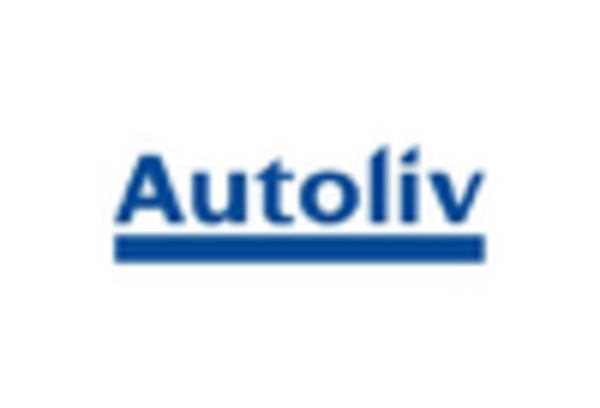Technological Advancements
Technological advancements play a pivotal role in shaping the Automotive Seat Belt Sensor Market. Innovations such as the integration of smart sensors and IoT capabilities are enhancing the functionality of seat belt sensors. These technologies allow for real-time data collection and analysis, improving the overall safety of vehicles. The market is witnessing a shift towards more sophisticated sensor systems that can detect not only seat belt usage but also the presence of passengers. This evolution is expected to attract investments, with the automotive safety market projected to reach USD 30 billion by 2026. Consequently, the Automotive Seat Belt Sensor Market is likely to benefit from these advancements, leading to increased adoption and market expansion.
Increasing Safety Regulations
The Automotive Seat Belt Sensor Market is experiencing a surge in demand due to the implementation of stringent safety regulations across various regions. Governments are mandating advanced safety features in vehicles, including seat belt sensors, to enhance passenger safety. For instance, regulations that require real-time monitoring of seat belt usage are becoming commonplace. This trend is likely to drive the market as manufacturers strive to comply with these regulations. The market for automotive safety systems, including seat belt sensors, is projected to grow significantly, with estimates suggesting a compound annual growth rate of over 7% in the coming years. As safety becomes a priority, the Automotive Seat Belt Sensor Market is poised for substantial growth.
Focus on Vehicle Electrification
The shift towards vehicle electrification is influencing the Automotive Seat Belt Sensor Market. As electric vehicles (EVs) gain popularity, manufacturers are increasingly integrating advanced safety features, including seat belt sensors, to meet consumer expectations. The electrification of vehicles is not only about reducing emissions but also enhancing safety and comfort. With projections indicating that EV sales could reach 30% of total vehicle sales by 2030, the demand for safety technologies is expected to rise correspondingly. This trend presents a substantial opportunity for the Automotive Seat Belt Sensor Market, as manufacturers seek to equip electric vehicles with state-of-the-art safety systems.
Growth of the Automotive Industry
The Automotive Seat Belt Sensor Market is closely linked to the overall growth of the automotive sector. As vehicle production increases, so does the demand for safety features, including seat belt sensors. The automotive industry is witnessing a resurgence, with production levels expected to rise by approximately 5% annually over the next few years. This growth is driven by factors such as rising disposable incomes and urbanization, leading to higher vehicle ownership rates. Consequently, the demand for automotive safety systems, including seat belt sensors, is anticipated to grow in tandem. The Automotive Seat Belt Sensor Market stands to gain significantly from this upward trend in automotive production.
Consumer Awareness and Demand for Safety Features
Consumer awareness regarding vehicle safety is on the rise, significantly impacting the Automotive Seat Belt Sensor Market. As individuals become more informed about the importance of safety features, there is a growing demand for vehicles equipped with advanced safety technologies, including seat belt sensors. Surveys indicate that a majority of consumers prioritize safety when purchasing vehicles, which is driving manufacturers to incorporate these features into their designs. The increasing focus on safety is expected to propel the market, with projections indicating that the automotive safety market could exceed USD 25 billion by 2025. This heightened consumer demand is likely to foster innovation within the Automotive Seat Belt Sensor Market.


















Leave a Comment